An Analysis of the Genetic Diversity, Genetic Structure, and Selection Signal of Beagle Dogs Using SNP Chips
Abstract
1. Introduction
2. Materials and Methods
2.1. Animals
2.2. Genotyping and Quality Control
2.3. Genetic Diversity Analysis
2.4. Genetic Relationships and Population Structure Analysis
2.5. Inbreeding Coefficient Analysis
2.6. Selection Signal Analysis and Functional Annotation
3. Results
3.1. Genetic Diversity Analysis
3.2. Population Structure Analysis
3.3. ROH-Based Inbreeding Coefficient Analysis
3.4. Cluster Analysis and Family Construction
3.5. Selection Signal Analysis and Functional Annotation
4. Discussion
5. Conclusions
Supplementary Materials
Author Contributions
Funding
Institutional Review Board Statement
Informed Consent Statement
Data Availability Statement
Conflicts of Interest
References
- American Kennel Club. The Complete Dog Book, 20th ed.; Ballantine Books: New York, NY, USA, 2006. [Google Scholar]
- American Kennel Club. Beagle Breed Standard. Available online: https://www.akc.org/dog-breeds/beagle/ (accessed on 25 December 2024).
- Fédération Cynologique Internationale. Beagle Breed Standard. Available online: https://www.fci.be/Nomenclature/Standards/161g06-en.pdf (accessed on 25 December 2024).
- American Kennel Club. Most Popular Dog Breeds. Available online: https://www.akc.org/most-popular-breeds/ (accessed on 25 December 2024).
- Bolman, B. Dogs for Life: Beagles, Drugs, and Capital in the Twentieth Century. J. Hist. Biol. 2022, 55, 147–179. [Google Scholar] [CrossRef] [PubMed]
- Lord, K.A.; Chen, F.L.; Karlsson, E.K. An Evolutionary Perspective on Dog Behavioral Genetics. Annu. Rev. Anim. Biosci. 2024, 13, 167–188. [Google Scholar] [CrossRef] [PubMed]
- Mochel, J.P.; Ward, J.L.; Blondel, T.; Kundu, D.; Merodio, M.M.; Zemirline, C.; Guillot, E.; Giebelhaus, R.T.; de la Mata, P.; Iennarella-Servantez, C.A.; et al. Preclinical modeling of metabolic syndrome to study the pleiotropic effects of novel antidiabetic therapy independent of obesity. Sci. Rep. 2024, 14, 20665. [Google Scholar] [CrossRef] [PubMed]
- Jeong, H.M.; Kim, H.; Jang, T.; Choi, A.; Park, J.B.; Park, C.; Lee, B.J. Release-modulating mechanism and comparative pharmacokinetics in beagle dogs of bethanechol-loaded oral dosage forms. Int. J. Pharm. 2024, 669, 125091. [Google Scholar] [CrossRef]
- Xin-pei, C.; Yu, Z.; Zhuo, L.; Gui-ying, C.; He, M.; Zhao-liang, S. Beagle dog model and mongrel dog model of rapid right ventricle pacing induced-atrial fi brillation. Acad. J. Chin. PLA Med. Sch. 2014, 35, 605–607. [Google Scholar]
- Masuda, Y.; Tsuruta, S.; Bermann, M.; Bradford, H.L.; Misztal, I. Comparison of models for missing pedigree in single-step genomic prediction. J. Anim. Sci. 2021, 99, skab019. [Google Scholar] [CrossRef]
- Freedman, A.H.; Schweizer, R.M.; Ortega-Del Vecchyo, D.; Han, E.; Davis, B.W.; Gronau, I.; Silva, P.M.; Galaverni, M.; Fan, Z.; Marx, P.; et al. Demographically-Based Evaluation of Genomic Regions under Selection in Domestic Dogs. PLoS Genet. 2016, 12, e1005851. [Google Scholar] [CrossRef]
- Tajima, F. Statistical method for testing the neutral mutation hypothesis by DNA polymorphism. Genetics 1989, 123, 585–595. [Google Scholar] [CrossRef]
- Ma, K.; Song, J.; Li, D.; Li, T.; Ma, Y. Genetic Diversity and Selection Signal Analysis of Hu Sheep Based on SNP50K BeadChip. Animals 2024, 14, 2789. [Google Scholar] [CrossRef]
- Storz, J.F. Using genome scans of DNA polymorphism to infer adaptive population divergence. Mol. Ecol. 2005, 14, 671–688. [Google Scholar] [CrossRef]
- Li, Y.; Huang, M.; Wang, Z.; Liu, X.; He, S.; Wang, T.; Ma, B.; Liu, J.; Li, X.; Xiong, J.; et al. Genomic selection analysis of morphological and adaptation traits in Chinese indigenous dog breeds. Front. Vet. Sci. 2023, 10, 1237780. [Google Scholar] [CrossRef] [PubMed]
- Schlamp, F.; van der Made, J.; Stambler, R.; Chesebrough, L.; Boyko, A.R.; Messer, P.W. Evaluating the performance of selection scans to detect selective sweeps in domestic dogs. Mol. Ecol. 2016, 25, 342–356. [Google Scholar] [CrossRef] [PubMed]
- Armstrong, E.E.; Li, C.; Campana, M.G.; Ferrari, T.; Kelley, J.L.; Petrov, D.A.; Solari, K.A.; Mooney, J.A. A Pipeline and Recommendations for Population and Individual Diagnostic SNP Selection in Non-Model Species. Mol. Ecol. Resour. 2024, 25, e14048. [Google Scholar] [CrossRef]
- Coates, B.S.; Sumerford, D.V.; Miller, N.J.; Kim, K.S.; Sappington, T.W.; Siegfried, B.D.; Lewis, L.C. Comparative performance of single nucleotide polymorphism and microsatellite markers for population genetic analysis. J. Hered. 2009, 100, 556–564. [Google Scholar] [CrossRef]
- Phan, L.; Zhang, H.; Wang, Q.; Villamarin, R.; Hefferon, T.; Ramanathan, A.; Kattman, B. The evolution of dbSNP: 25 years of impact in genomic research. Nucleic Acids Res. 2024, 53, D925–D931. [Google Scholar] [CrossRef]
- Lee, J.; Jung, J.H.; Oh, S.H. Enhancing animal breeding through quality control in genomic data-a review. J. Anim. Sci. Technol. 2024, 66, 1099–1108. [Google Scholar] [CrossRef]
- Purcell, S.; Neale, B.; Todd-Brown, K.; Thomas, L.; Ferreira, M.A.; Bender, D.; Maller, J.; Sklar, P.; de Bakker, P.I.; Daly, M.J.; et al. PLINK: A tool set for whole-genome association and population-based linkage analyses. Am. J. Hum. Genet. 2007, 81, 559–575. [Google Scholar] [CrossRef]
- Zhao, S.; Jing, W.; Samuels, D.C.; Sheng, Q.; Shyr, Y.; Guo, Y. Strategies for processing and quality control of Illumina genotyping arrays. Brief. Bioinform. 2018, 19, 765–775. [Google Scholar] [CrossRef]
- Zhu, M.; Wang, L.; Ma, Z.; Mao, Y.; Wang, G.; Zheng, R.; Zuo, B.; Wang, Y. Analysis of the Genetic Diversity and Genetic Structure of Jiangshan Black Pigs Using Single Nucleotide Polymorphism (SNP) Chips. Animals 2024, 14, 2660. [Google Scholar] [CrossRef]
- Yang, J.; Lee, S.H.; Goddard, M.E.; Visscher, P.M. GCTA: A tool for genome-wide complex trait analysis. Am. J. Hum. Genet. 2011, 88, 76–82. [Google Scholar] [CrossRef]
- VanRaden, P.M. Efficient methods to compute genomic predictions. J. Dairy Sci. 2008, 91, 4414–4423. [Google Scholar] [CrossRef] [PubMed]
- Bradbury, P.J.; Zhang, Z.; Kroon, D.E.; Casstevens, T.M.; Ramdoss, Y.; Buckler, E.S. TASSEL: Software for association mapping of complex traits in diverse samples. Bioinformatics 2007, 23, 2633–2635. [Google Scholar] [CrossRef] [PubMed]
- Letunic, I.; Bork, P. Interactive Tree of Life (iTOL) v6: Recent updates to the phylogenetic tree display and annotation tool. Nucleic Acids Res. 2024, 52, W78–W82. [Google Scholar] [CrossRef]
- McQuillan, R.; Leutenegger, A.-L.; Abdel-Rahman, R.; Franklin, C.S.; Pericic, M.; Barac-Lauc, L.; Smolej-Narancic, N.; Janicijevic, B.; Polasek, O.; Tenesa, A.; et al. Runs of Homozygosity in European Populations. Am. J. Hum. Genet. 2008, 83, 359–372. [Google Scholar] [CrossRef]
- Danecek, P.; Auton, A.; Abecasis, G.; Albers, C.A.; Banks, E.; DePristo, M.A.; Handsaker, R.E.; Lunter, G.; Marth, G.T.; Sherry, S.T.; et al. The variant call format and VCFtools. Bioinformatics 2011, 27, 2156–2158. [Google Scholar] [CrossRef]
- Fonseca, P.A.S.; Suarez-Vega, A.; Marras, G.; Canovas, A. GALLO: An R package for genomic annotation and integration of multiple data sources in livestock for positional candidate loci. Gigascience 2020, 9, giaa149. [Google Scholar] [CrossRef]
- Huang, D.W.; Sherman, B.T.; Tan, Q.; Kir, J.; Liu, D.; Bryant, D.; Guo, Y.; Stephens, R.; Baseler, M.W.; Lane, H.C.; et al. DAVID Bioinformatics Resources: Expanded annotation database and novel algorithms to better extract biology from large gene lists. Nucleic Acids Res. 2007, 35, W169–W175. [Google Scholar] [CrossRef]
- Tang, D.; Chen, M.; Huang, X.; Zhang, G.; Zeng, L.; Zhang, G.; Wu, S.; Wang, Y. SRplot: A free online platform for data visualization and graphing. PLoS ONE 2023, 18, e0294236. [Google Scholar] [CrossRef]
- Garcia, L.S.A.; Vergara, A.M.C.; Herrera, P.Z.; Puente, J.M.A.; Barro, A.L.P.; Dunner, S.; Marques, C.S.J.; Bermejo, J.V.D.; Martinez, A.M. Genetic Structure of the Ca Rater Mallorqui Dog Breed Inferred by Microsatellite Markers. Animals 2022, 12, 2733. [Google Scholar] [CrossRef]
- Talenti, A.; Dreger, D.L.; Frattini, S.; Polli, M.; Marelli, S.; Harris, A.C.; Liotta, L.; Cocco, R.; Hogan, A.N.; Bigi, D.; et al. Studies of modern Italian dog populations reveal multiple patterns for domestic breed evolution. Ecol. Evol. 2018, 8, 2911–2925. [Google Scholar] [CrossRef]
- Wade, C.M. Inbreeding and genetic diversity in dogs: Results from DNA analysis. Vet. J. 2011, 189, 183–188. [Google Scholar] [CrossRef] [PubMed]
- Leroy, G. Genetic diversity, inbreeding and breeding practices in dogs: Results from pedigree analyses. Vet. J. 2011, 189, 177–182. [Google Scholar] [CrossRef] [PubMed]
- Choi, B.H.; Wijayananda, H.I.; Lee, S.H.; Lee, D.H.; Kim, J.S.; Oh, S.I.; Park, E.W.; Lee, C.K.; Lee, S.H. Genome-wide analysis of the diversity and ancestry of Korean dogs. PLoS ONE 2017, 12, e0188676. [Google Scholar] [CrossRef] [PubMed]
- Yang, Q.; Chen, H.; Ye, J.; Liu, C.; Wei, R.; Chen, C.; Huang, L. Genetic Diversity and Signatures of Selection in 15 Chinese Indigenous Dog Breeds Revealed by Genome-Wide SNPs. Front. Genet. 2019, 10, 1174. [Google Scholar] [CrossRef]
- Brito, L.F.; Kijas, J.W.; Ventura, R.V.; Sargolzaei, M.; Porto-Neto, L.R.; Canovas, A.; Feng, Z.; Jafarikia, M.; Schenkel, F.S. Genetic diversity and signatures of selection in various goat breeds revealed by genome-wide SNP markers. BMC Genom. 2017, 18, 229. [Google Scholar] [CrossRef]
- Botstein, D.; White, R.L.; Skolnick, M.; Davis, R.W. Construction of a genetic linkage map in man using restriction fragment length polymorphisms. Am. J. Hum. Genet. 1980, 32, 314–331. [Google Scholar]
- Nunney, L. The effect of body size and inbreeding on cancer mortality in breeds of the domestic dog: A test of the multi-stage model of carcinogenesis. R. Soc. Open Sci. 2024, 11, 231356. [Google Scholar] [CrossRef]
- Hayes, B.J.; Bowman, P.J.; Chamberlain, A.J.; Goddard, M.E. Invited review: Genomic selection in dairy cattle: Progress and challenges. J. Dairy Sci. 2009, 92, 433–443. [Google Scholar] [CrossRef]
- Gibson, J.; Morton, N.E.; Collins, A. Extended tracts of homozygosity in outbred human populations. Hum. Mol. Genet. 2006, 15, 789–795. [Google Scholar] [CrossRef]
- Leroy, G.; Baumung, R. Mating practices and the dissemination of genetic disorders in domestic animals, based on the example of dog breeding. Anim. Genet. 2011, 42, 66–74. [Google Scholar] [CrossRef]
- Mabunda, R.S.; Nephawe, K.A.; Mtileni, B.; Makgahlela, M.L. Pedigree-Based Genetic Diversity in the South African Boerboel Dog Breed. Animals 2024, 14, 975. [Google Scholar] [CrossRef] [PubMed]
- Jolfayi, A.G.; Kohansal, E.; Ghasemi, S.; Naderi, N.; Hesami, M.; Mozafarybazargany, M.; Moghadam, M.H.; Fazelifar, A.F.; Maleki, M.; Kalayinia, S. Exploring TTN variants as genetic insights into cardiomyopathy pathogenesis and potential emerging clues to molecular mechanisms in cardiomyopathies. Sci. Rep. 2024, 14, 5315. [Google Scholar] [CrossRef] [PubMed]
- Komatsu, Y.; Sukegawa, S.; Yamashita, M.; Katsuda, N.; Tong, B.; Ohta, T.; Kose, H.; Yamada, T. Identification of genes showing differential expression profile associated with growth rate in skeletal muscle tissue of Landrace weanling pig. J. Genet. 2016, 95, 341–347. [Google Scholar] [CrossRef] [PubMed]
- Gaar-Humphreys, K.R.; Spanjersberg, T.C.F.; Santarelli, G.; Grinwis, G.C.M.; Szatmari, V.; Roelen, B.A.J.; Vink, A.; van Tintelen, J.P.; Asselbergs, F.W.; Fieten, H.; et al. Genetic Basis of Dilated Cardiomyopathy in Dogs and Its Potential as a Bidirectional Model. Animals 2022, 12, 1679. [Google Scholar] [CrossRef]
- Chu, H.; Mazmanian, S.K. Innate immune recognition of the microbiota promotes host-microbial symbiosis. Nat. Immunol. 2013, 14, 668–675. [Google Scholar] [CrossRef]
- Sansone, C.; Balestra, C.; Pistelli, L.; Del Mondo, A.; Osca, D.; Brunet, C.; Crocetta, F. A Comparative Analysis of Mucus Immunomodulatory Properties from Seven Marine Gastropods from the Mediterranean Sea. Cells 2022, 11, 2340. [Google Scholar] [CrossRef]
- Zhu, A.; Wei, L.; Hu, S.; Yang, C.; Chen, C.; Zhou, Z.; Pan, Z. Characterisation and functional analysis of canine TLR5. Innate Immun. 2020, 26, 451–458. [Google Scholar] [CrossRef]
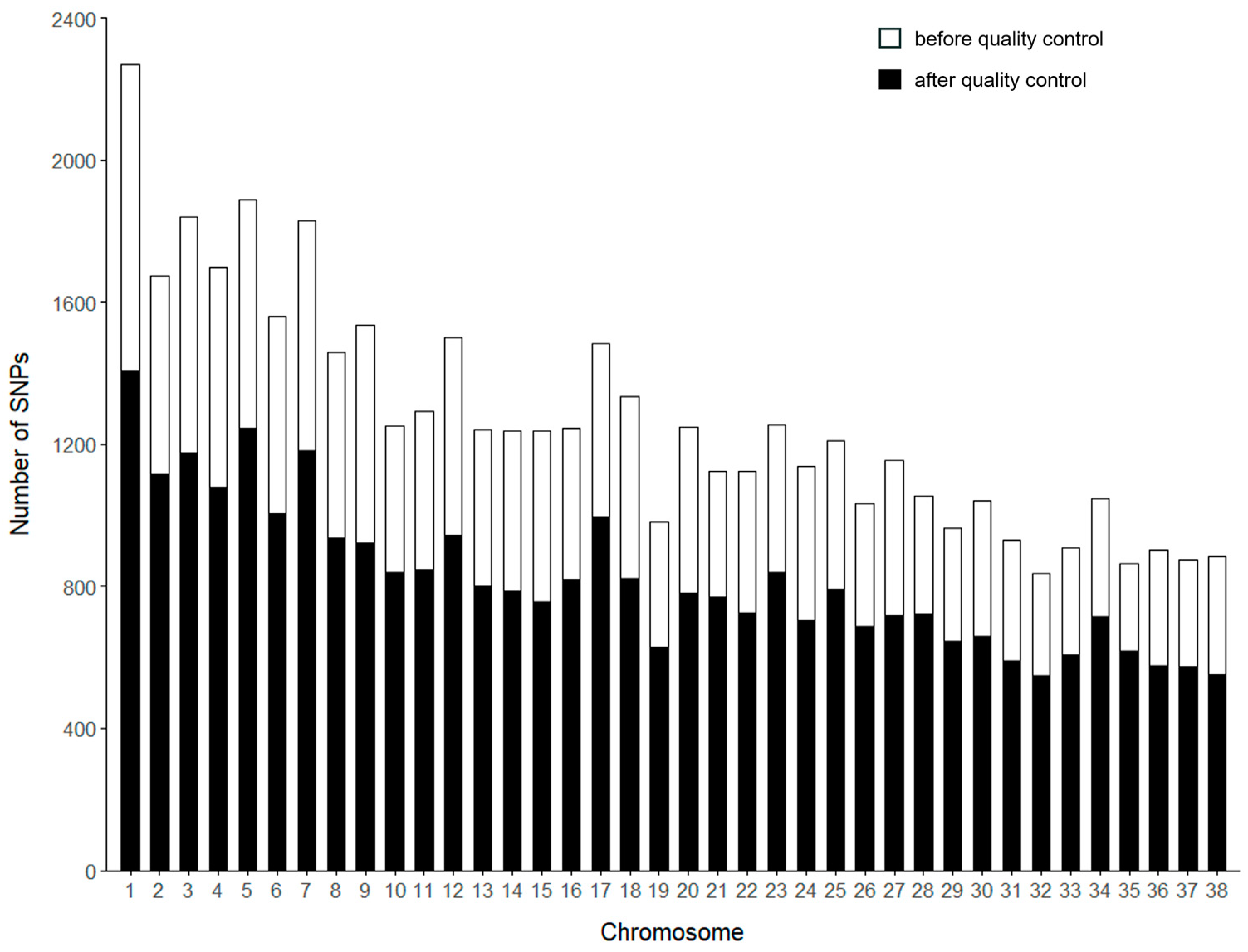
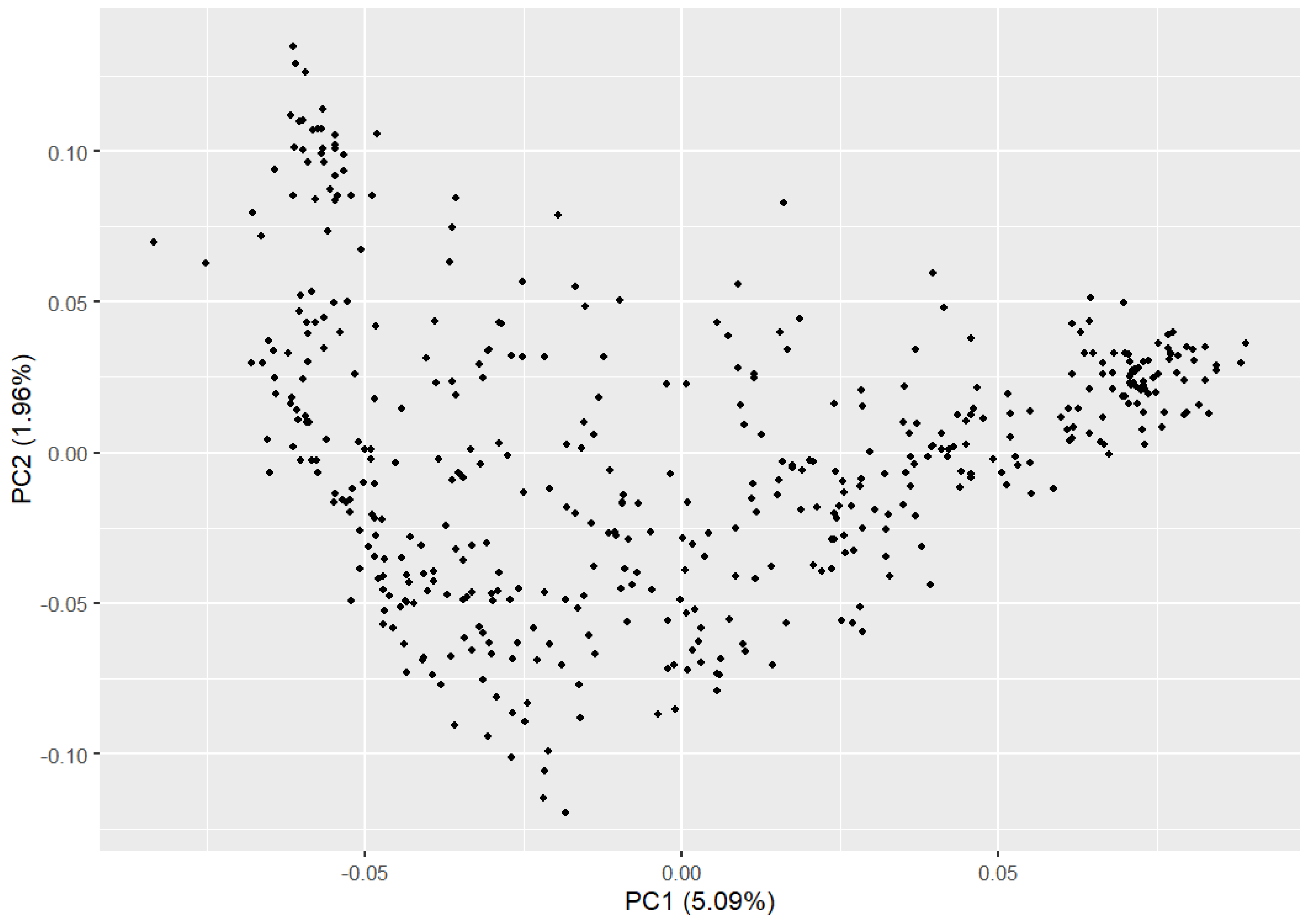
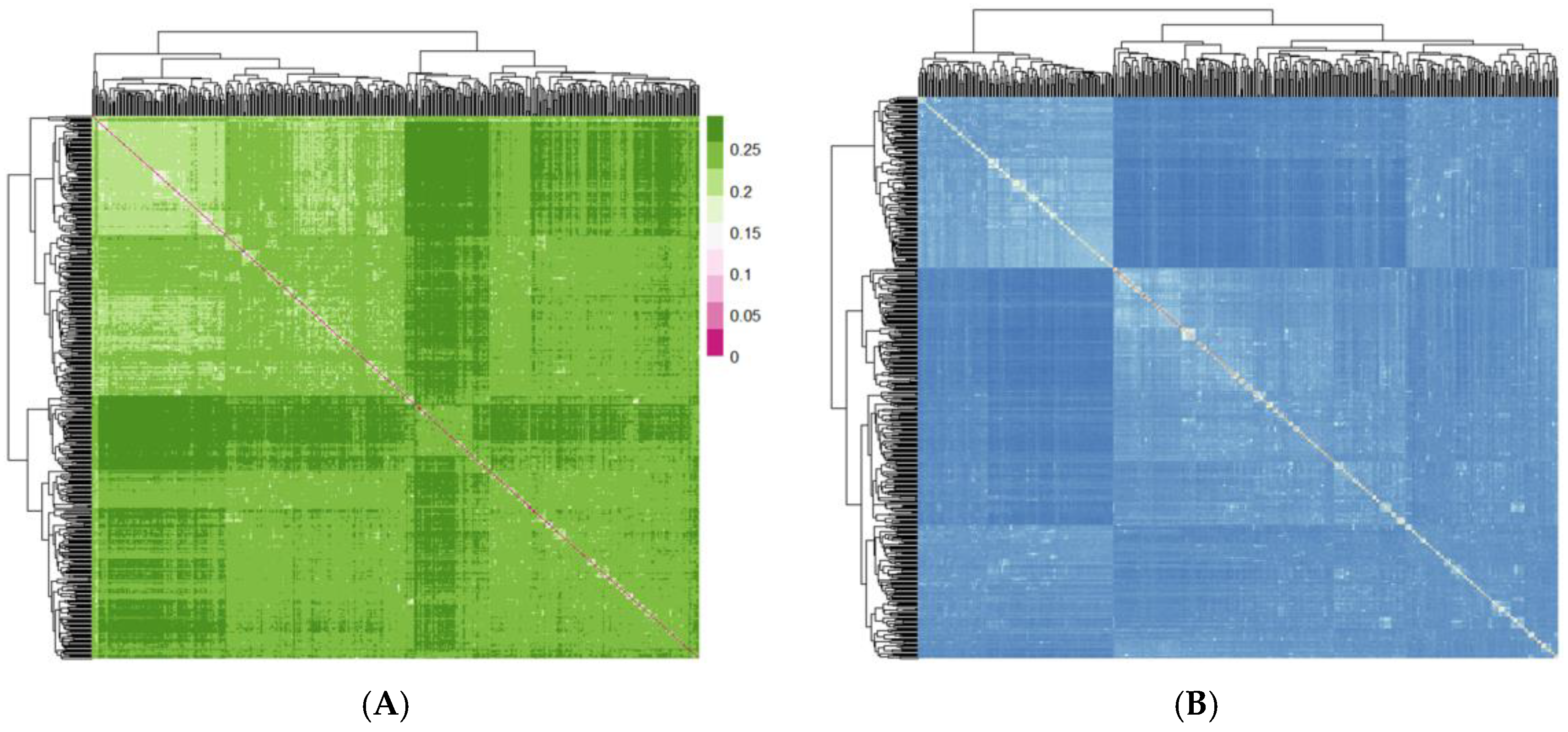
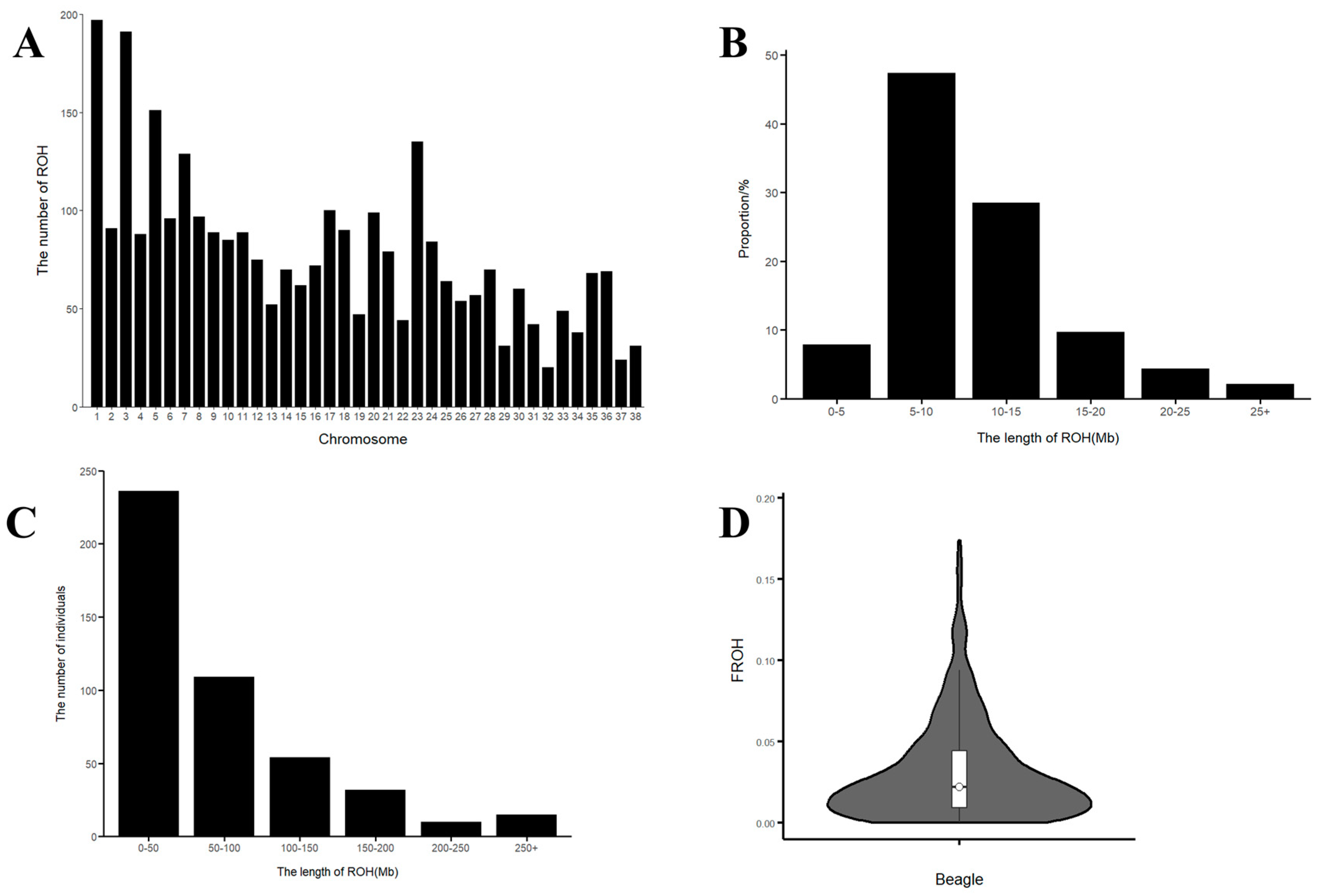
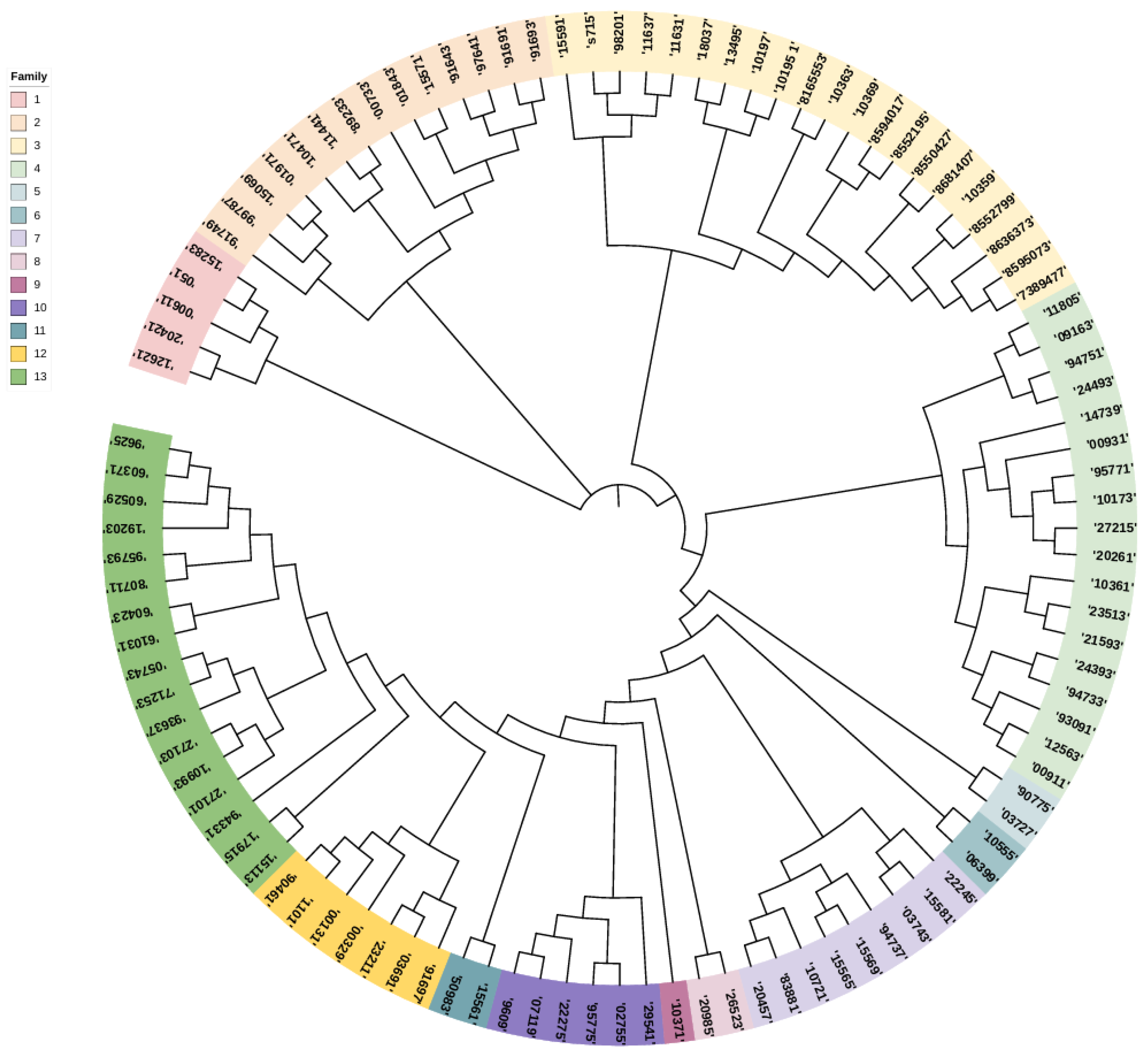
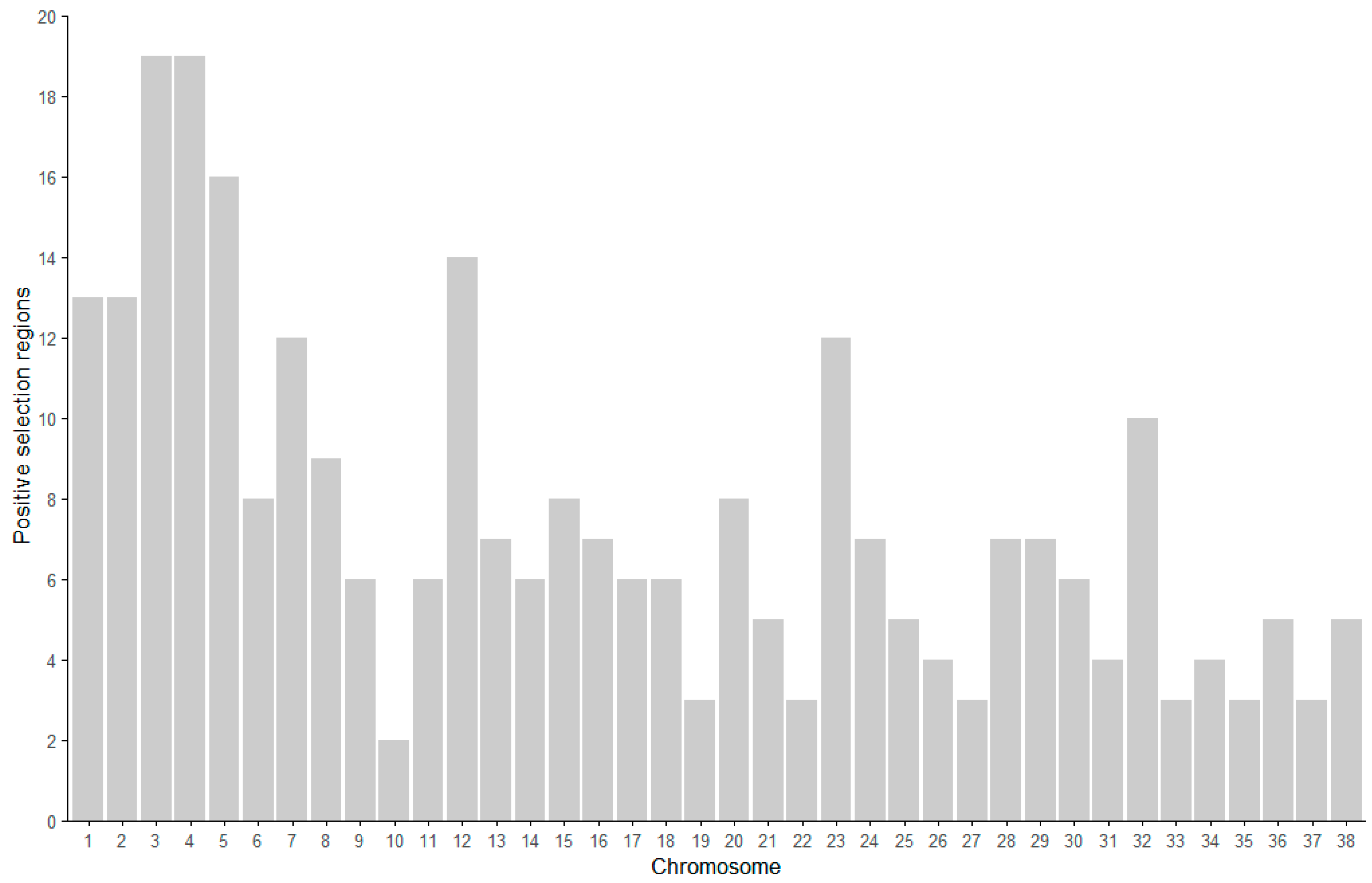
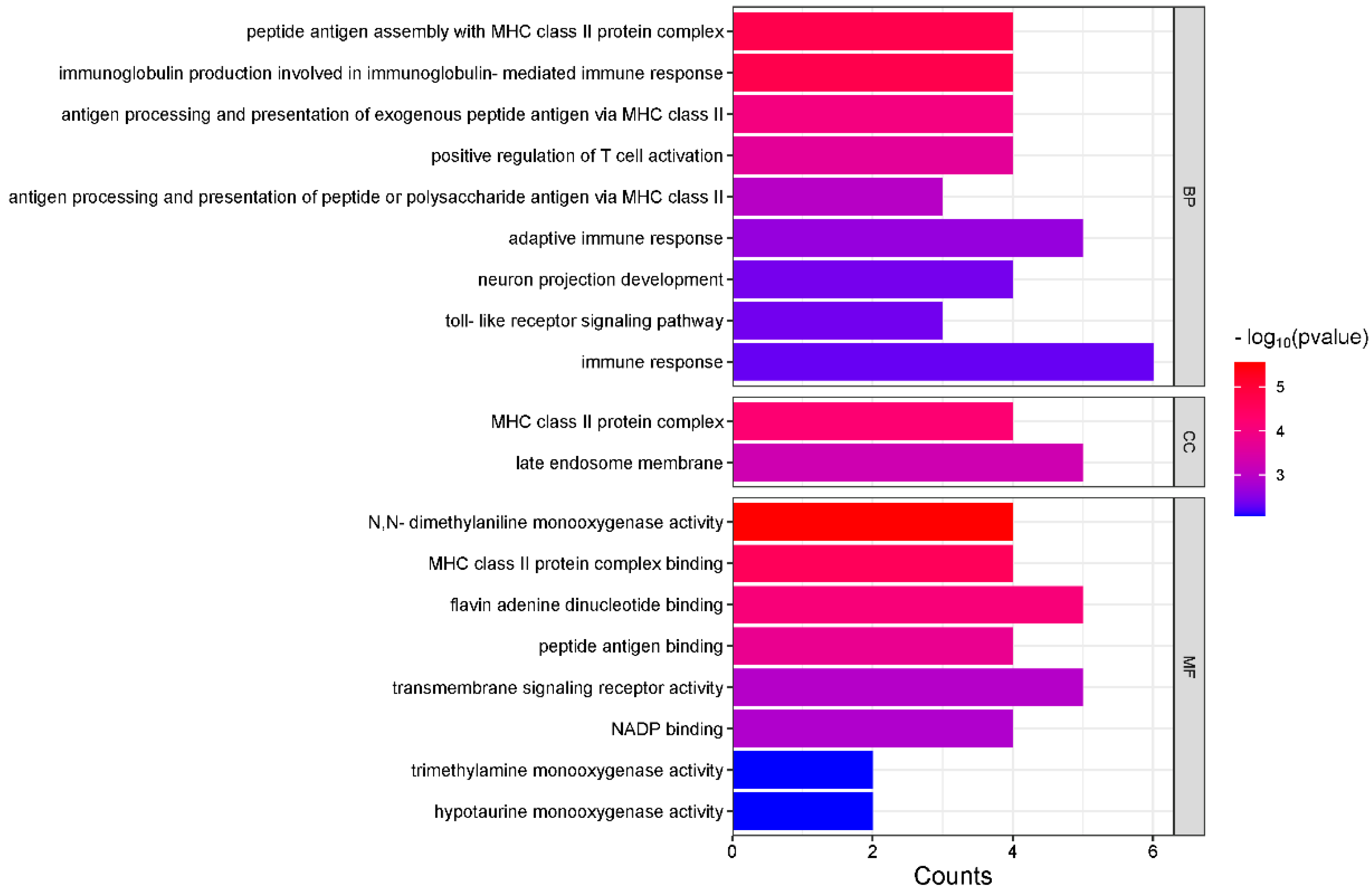

| Quality Control Standards | Number of SNP Tags | Number of Beagle Dogs |
|---|---|---|
| Total number of SNPs | 48,304 | 459 samples (108 males and 351 females) |
| SNP with MAF < 0.01 | 10,925 | 0 |
| SNP with call rate < 0.90 | 6181 | 0 |
| Individuals with call rate < 90% | 0 | 3 samples (2 males and 1 female) |
| SNPs used after quality control | 31,198 | 456 samples (106 males and 350 females) |
| Genetic Diversity Parameters | Parameter |
|---|---|
| MAF | 0.224 |
| HO | 0.303 |
| HE | 0.305 |
| PIC | 0.305 |
| PN | 0.849 |
| Ae | 1.513 |
| Chromosome | Start Position (bp) | End Position (bp) | Number of SNPs | Tajima’s D Value | Nearby Gene |
|---|---|---|---|---|---|
| 36 | 22,170,000 | 22,180,000 | 4 | −1.200 | TTN |
| 20 | 36,340,000 | 36,350,000 | 8 | −1.031 | CACNA1D |
| 9 | 53,550,000 | 53,560,000 | 2 | −0.934 | SERPINA4 |
| 3 | 73,540,000 | 73,550,000 | 2 | −0.881 | TLR5 |
| 3 | 84,580,000 | 84,590000 | 3 | −0.873 | HMCN2 |
| 34 | 25,100,000 | 25,110,000 | 3 | −0.868 | ATP13A4 |
| 12 | 2,160,000 | 2,170,000 | 2 | −0.863 | DLA-DRA |
| 25 | 44,160,000 | 44,170,000 | 2 | −0.863 | EIF4E2 |
| 16 | 28,450,000 | 28,460,000 | 2 | −0.846 | KCNU1 |
| 7 | 27,560,000 | 27,570,000 | 2 | −0.845 | FMO3 |
Disclaimer/Publisher’s Note: The statements, opinions and data contained in all publications are solely those of the individual author(s) and contributor(s) and not of MDPI and/or the editor(s). MDPI and/or the editor(s) disclaim responsibility for any injury to people or property resulting from any ideas, methods, instructions or products referred to in the content. |
© 2025 by the authors. Licensee MDPI, Basel, Switzerland. This article is an open access article distributed under the terms and conditions of the Creative Commons Attribution (CC BY) license (https://creativecommons.org/licenses/by/4.0/).
Share and Cite
Wang, H.; Yin, Y.; Zhang, C.; Li, F.; Zhao, H.; Liu, Z.; Sun, W.; Zhou, L. An Analysis of the Genetic Diversity, Genetic Structure, and Selection Signal of Beagle Dogs Using SNP Chips. Genes 2025, 16, 358. https://doi.org/10.3390/genes16040358
Wang H, Yin Y, Zhang C, Li F, Zhao H, Liu Z, Sun W, Zhou L. An Analysis of the Genetic Diversity, Genetic Structure, and Selection Signal of Beagle Dogs Using SNP Chips. Genes. 2025; 16(4):358. https://doi.org/10.3390/genes16040358
Chicago/Turabian StyleWang, Haolong, Yanbo Yin, Can Zhang, Fangzheng Li, Haiping Zhao, Zhen Liu, Weili Sun, and Lisheng Zhou. 2025. "An Analysis of the Genetic Diversity, Genetic Structure, and Selection Signal of Beagle Dogs Using SNP Chips" Genes 16, no. 4: 358. https://doi.org/10.3390/genes16040358
APA StyleWang, H., Yin, Y., Zhang, C., Li, F., Zhao, H., Liu, Z., Sun, W., & Zhou, L. (2025). An Analysis of the Genetic Diversity, Genetic Structure, and Selection Signal of Beagle Dogs Using SNP Chips. Genes, 16(4), 358. https://doi.org/10.3390/genes16040358





